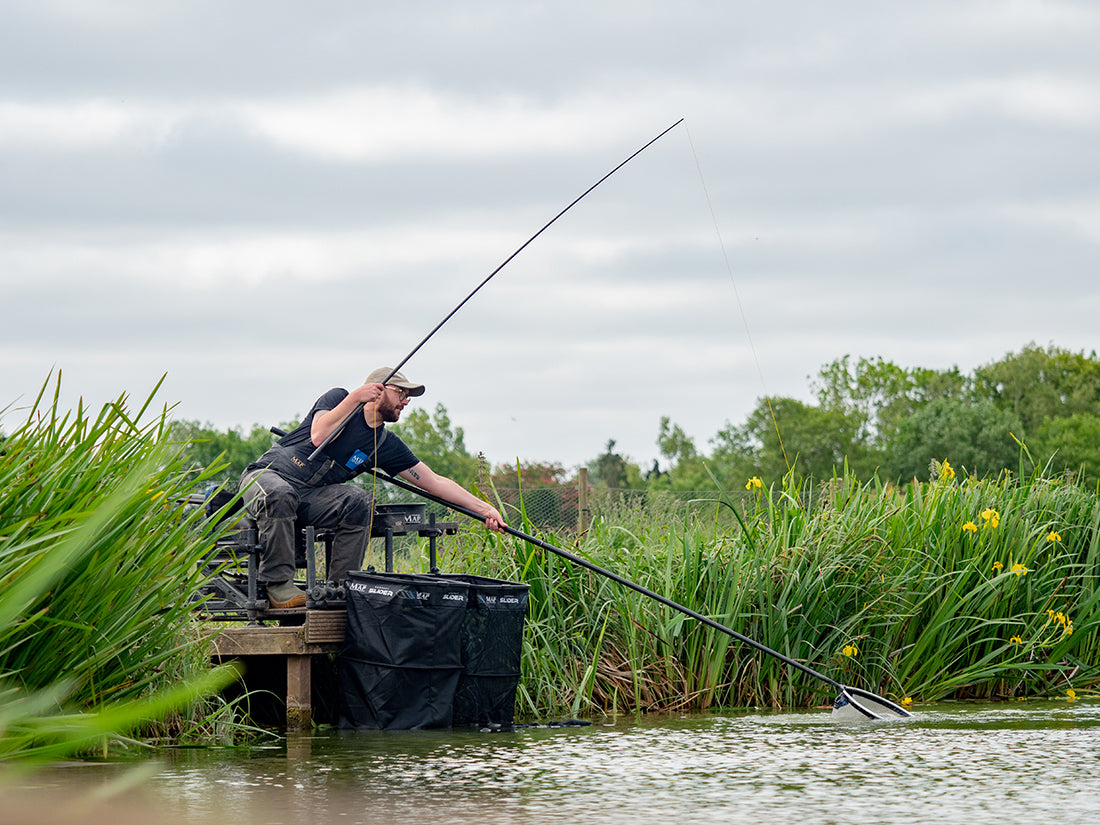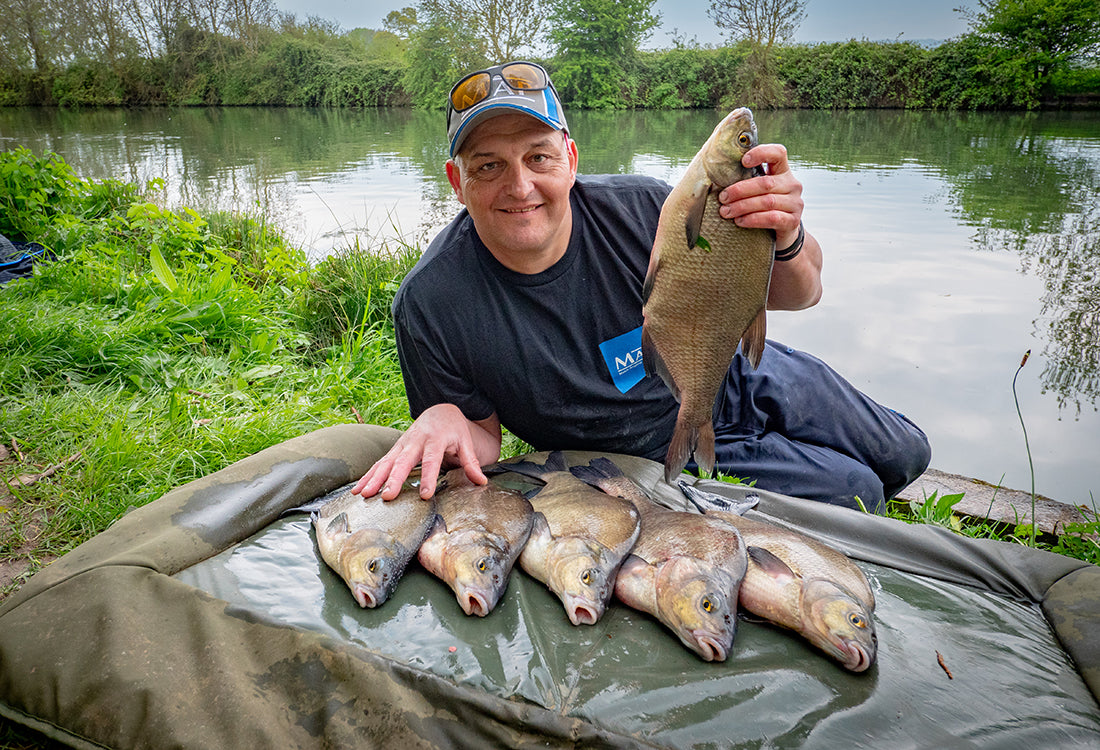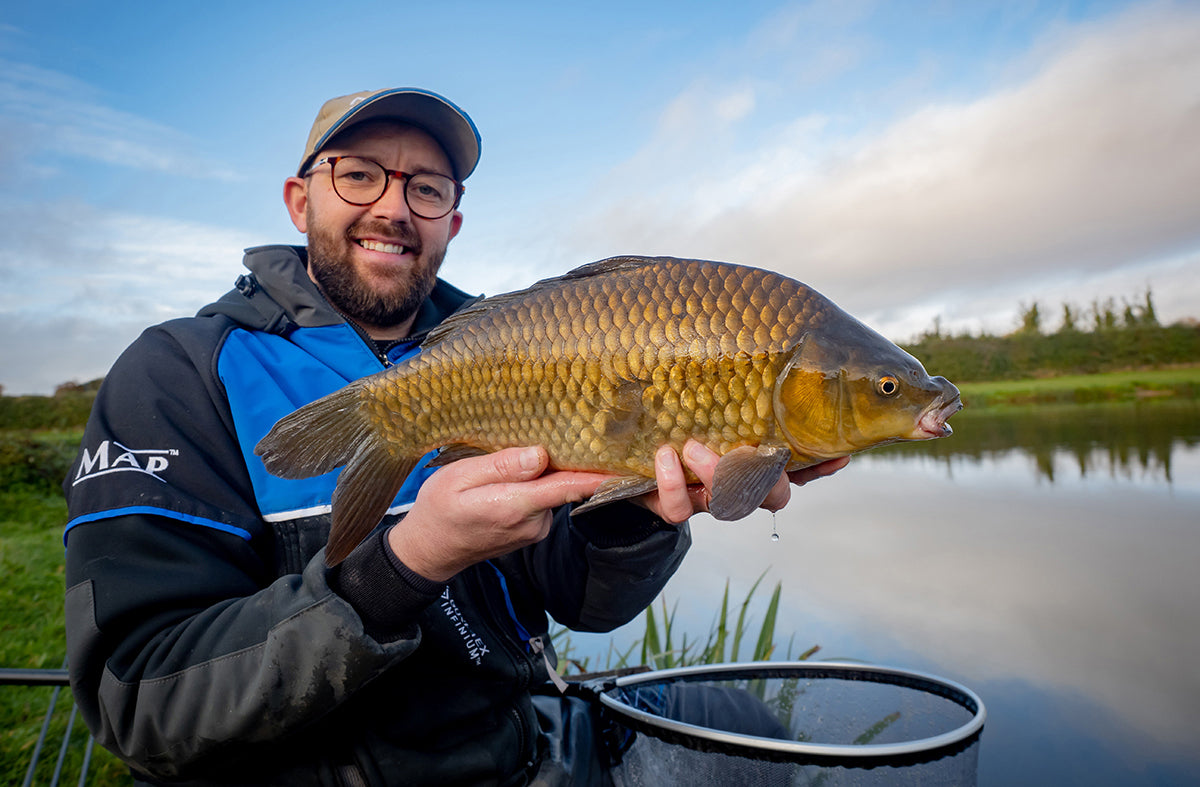Short & Sweet!
Fishing the short pole on commercial venues accounts for hundreds and possibly thousands of match wins every year, there are however, many variables which can make a huge difference, depth, the make-up of the bottom, bait choices and even different species of fish can all play a huge part in getting your approach right.

The short line is an excellent starting point in many matches, giving you the opportunity to survey the anglers around you and also to catch that couple of resident fish which can often be caught soon after the all-in!
It can also provide the angler with an unbelievable finish to the match as the fish move closer in with confidence as they feed with more aggression in the closing stages, but are you fishing too far out with a standard top two plus two?
It can also provide the angler with an unbelievable finish to the match as the fish move closer in with confidence as they feed with more aggression in the closing stages, but are you fishing too far out with a standard top two plus two?

According to MAP backed Mark Malin, you could well be! We caught up with him on the banks of the Canal Lake at Alvechurch Fisheries to find out more about the tactics he’s been using to put together some huge weights at the venue in recent weeks.
Distance Matters
Here on the Canal Lake at Alvechurch we’re faced with a pretty typical canal style snake lake which most anglers are used to seeing – what makes this one a little difference is that the lake was lazer dug which means it’s perfectly uniformed in its contours all around the lake which makes getting your rigs right extremely easy.

With near and far shelves offering perfect depths the approach for a typical match in the summer months is to always start short. This can help you to catch a few early fish and then move across to the far bank cover either catching on the bottom or shallow against the reeds to fill the middle hours of the match, before catching well short or in the edge later.
What may surprise people is how close I like to fish both in the margin and on the short pole, at Alvechurch this means fishing just a topkit on both of these lines and its effectiveness is incredible.

I feel this works better than a standard 5m line because it not only puts me in a better depth for the summer months. It also means I’m fishing further up the shelf on a hard bottom and away from the softer silt. This makes life so much easier, the bites are cleaner with less foul hooked fish and fizzing to contend with.
The canal lake also has a massive head of barbel, which love to hug the near bank slope even sometimes using keepnets as a bit of cover, so it makes complete sense to make the most of the features.
What may surprise people is how close I like to fish both in the margin and on the short pole, at Alvechurch this means fishing just a topkit on both of these lines and its effectiveness is incredible.

I feel this works better than a standard 5m line because it not only puts me in a better depth for the summer months. It also means I’m fishing further up the shelf on a hard bottom and away from the softer silt. This makes life so much easier, the bites are cleaner with less foul hooked fish and fizzing to contend with.
The canal lake also has a massive head of barbel, which love to hug the near bank slope even sometimes using keepnets as a bit of cover, so it makes complete sense to make the most of the features.

Just a year or so ago, we used to actually try and avoid the barbel as they didn’t weigh much and they took too long to land compared with carp.
Now, they’re all 2lb and bigger so, they’re a viable target that cannot be ignored when looking to put big weights together.
The beauty of fishing for the barbel is the speed at which you can get your next bite after catching a fish, when they arrive in numbers, action can come thick and fast!
Now, they’re all 2lb and bigger so, they’re a viable target that cannot be ignored when looking to put big weights together.
The beauty of fishing for the barbel is the speed at which you can get your next bite after catching a fish, when they arrive in numbers, action can come thick and fast!

Barbel Bagging!
My set up has one common theme which is strength and durability!
This isn’t because of the size of the fish as-such, it’s more to do with landing the barbel as quickly as possible. The carp here weigh much more than the barbel, but they just fight so hard and with lighter tackle you can find yourself playing barbel for far too long and run the risk of being left behind.

Today, I’ve got my favourite TKS Solid Core Hybrid elastic in a 14-16 size through a TKS Power Kit, this I feel is the ideal elastic for not only catching big weights, but subduing powerful fish in as little time as possible.
My rigs are very straightforward too, 0.19mm Optimum Power main line to a 0.17mm hook length down to a size 16 or 14 B911 X Strong hook.
My rigs are very straightforward too, 0.19mm Optimum Power main line to a 0.17mm hook length down to a size 16 or 14 B911 X Strong hook.

Float wise I’ve got two rigs set up, both are identical set ups, the only difference being the margin rig is a couple of inches shallower than the topkit line in front of me.
On this line, I have a 4x14 MAP MF3 is the ideal choice, including a nice thick bristle to help me differentiate between liners and proper bites which is important when barbel are the targets.
On this line, I have a 4x14 MAP MF3 is the ideal choice, including a nice thick bristle to help me differentiate between liners and proper bites which is important when barbel are the targets.

Shotting patterns on both are the same – a simple strung-out bulk of shot around 8 inches from the hook in the 2.5/3ft deep swims.
I feel this is a brilliant shotting pattern to use when barbel are a main target species as they often watch the hook bait fall and bites can be instantaneous as the float settles, with a bulk of shot right above the hook length, I may miss out on a few of these opportunities.
Bait
While pellets are an excellent choice on any commercial venue, when I’m looking to fish short where carp and barbel are the main species like they are here at Alvechurch, maggots play a huge part in my approach.
I feel this is a brilliant shotting pattern to use when barbel are a main target species as they often watch the hook bait fall and bites can be instantaneous as the float settles, with a bulk of shot right above the hook length, I may miss out on a few of these opportunities.
Bait
While pellets are an excellent choice on any commercial venue, when I’m looking to fish short where carp and barbel are the main species like they are here at Alvechurch, maggots play a huge part in my approach.

Once a shoal of barbel arrive in your peg, nothing holds them better than plenty of maggots!
Today I’ve bought four pints for our short session, but this could easily be more if bait limits allow on your venue and they feed with such aggression that sometimes it would seem that you could never overfeed your peg.
Today I’ve bought four pints for our short session, but this could easily be more if bait limits allow on your venue and they feed with such aggression that sometimes it would seem that you could never overfeed your peg.

The top kit line in front of my nets is where I’m going to be planning to catch most of the barbel today. I’ve also got the other rig for fishing a top kit down the edge to my left. I expect a few more carp to put in an appearance in the margin, so I’ll be feeding some soaked micros with the maggots as well on this line.

Sometimes, fishing in the margin can be better than out in front of the peg itself, this can be purely down to the conditions or depth and sometimes the extra cover can be key so it’s always worth keeping an open mind when it comes to line selection.
Kicking Off
To start the match, I simply feed twice on the short line with two lots of 30 maggots, this is enough to get things going and attract those resident fish that you need to catch to get off to a good start.
Kicking Off
To start the match, I simply feed twice on the short line with two lots of 30 maggots, this is enough to get things going and attract those resident fish that you need to catch to get off to a good start.

I see a lot of anglers going straight in with a big pot at this stage and it’s something I don’t feel is necessary.
In the opening part of any match, the fish are going to go either way – they’re going to feed like crazy or it’s going to be a slow start, so by taking a steady approach to begin with, I can’t mess my peg up regardless of how well the lake is going to fish.
In the opening part of any match, the fish are going to go either way – they’re going to feed like crazy or it’s going to be a slow start, so by taking a steady approach to begin with, I can’t mess my peg up regardless of how well the lake is going to fish.

When fishing with maggots a lot of anglers are put off by getting bitted out by small fish, but in most cases, if this is a problem it’s more likely that the bigger fish aren’t in the peg and when they do turn up, the small fish won’t get a look in!
The only time I’d move away from loose feeding on my open water line would be if the water was deeper than 5ft, this is when big potting maggots can pay off, feeding larger quantities but less often to ensure the bait gets to the bottom.
The only time I’d move away from loose feeding on my open water line would be if the water was deeper than 5ft, this is when big potting maggots can pay off, feeding larger quantities but less often to ensure the bait gets to the bottom.

I don’t feed the margin line straight away until I have a good picture of how the day is going to pan out.
The main difference between feeding short and down the edge on this venue is that down the edge I do like to employ the use of a big pot at times to introduce larger quantities of maggots and micro pellets on a more but less often basis.
The main difference between feeding short and down the edge on this venue is that down the edge I do like to employ the use of a big pot at times to introduce larger quantities of maggots and micro pellets on a more but less often basis.

This is purely down to the amount of fish you can have coming into the peg at once in the margin and by dump feeding, I can keep the amount of fish to a minimum, leading to cleaner bites and less foul hooked fish.
Final Flourish!
Fishing short is an unbelievable way of putting together a big weight later in the match, by the time I have two hours of the match left I want to be fishing short and if I catch there, I’m likely to catch in the margin too and here at Alvechurch that is no different.
Final Flourish!
Fishing short is an unbelievable way of putting together a big weight later in the match, by the time I have two hours of the match left I want to be fishing short and if I catch there, I’m likely to catch in the margin too and here at Alvechurch that is no different.

What is important is how you build the peg as you gear up for a great last two hours. Like I said earlier, I like to start short, but after that initial run of bites, I may go longer to the island to keep my catch rate ticking over while I build the short line for later in the match.
Timing is everything when fishing the short pole, I like to feed every 90 seconds and by gradually increasing the number of maggots with each feed every hour is a great way of building and holding the fish in the peg.
Later in the match there is always more fish feeding so adjusting your feed is necessary to hold them.
The Session
After setting up a couple of rigs for the short line in front of my nets and down the edge both on just a top kit, I couldn’t wait to get started!
Kicking off by feeding 20 maggots twice over the short line, baiting up with double red maggot it wasn’t long before I had my first bite of the day, a short scrap on the 14-16 Hybrid elastic saw the fish netted – a carp of around 4lb.
Timing is everything when fishing the short pole, I like to feed every 90 seconds and by gradually increasing the number of maggots with each feed every hour is a great way of building and holding the fish in the peg.
Later in the match there is always more fish feeding so adjusting your feed is necessary to hold them.
The Session
After setting up a couple of rigs for the short line in front of my nets and down the edge both on just a top kit, I couldn’t wait to get started!
Kicking off by feeding 20 maggots twice over the short line, baiting up with double red maggot it wasn’t long before I had my first bite of the day, a short scrap on the 14-16 Hybrid elastic saw the fish netted – a carp of around 4lb.

I expected carp to arrive on the scene first, and so it proved as I caught quite a few, all lovely fish in great condition. It can take a couple of hours before the large shoals of barbel turn up but when they do, it can be hectic action.
After a brief quiet spell, the float shot under after laying the rig back in and with the tell-tale jagging and trying to get into every reed bed in the venue I had my suspicions that I’d hooked my first barbel of the day.
After a brief quiet spell, the float shot under after laying the rig back in and with the tell-tale jagging and trying to get into every reed bed in the venue I had my suspicions that I’d hooked my first barbel of the day.

After a great scrap a 3lb barbel surfaced and was scooped up, this barbel was the turning point of the session!
All of a sudden, a big shoal of barbel had arrived, given away by line bites and the water colouring up where I’d fed! At this point I started feeding the margin line with the big pot too feeding good amounts of micros and maggots but I carried on catching barbel short for a while before I had a look on that line.
All of a sudden, a big shoal of barbel had arrived, given away by line bites and the water colouring up where I’d fed! At this point I started feeding the margin line with the big pot too feeding good amounts of micros and maggots but I carried on catching barbel short for a while before I had a look on that line.

At times the barbel were feeding so well they’d just rip the elastic from the pole tip! It’s easy to see why big weights are possible when the fish are feeding like this, and of course fishing so close in lends itself to landing the fish quickly too.
The constant swirls on the margin line were too tempting and I had to have a look, dropping in with three maggots on the hook, I didn’t have to wait long before I was catching a carp every single cast down the edge, which was a great way to end the feature.
The constant swirls on the margin line were too tempting and I had to have a look, dropping in with three maggots on the hook, I didn’t have to wait long before I was catching a carp every single cast down the edge, which was a great way to end the feature.

With 150lb of barbel and carp caught in just a few hours, it had been an excellent day at Alvechurch. What is important to emphasise though is how getting your approach right on your short lines is so important.
Getting it right isn't just about your bait selection and depths but the distance you’re fishing too – on many occasions shorter than short is the way to go!
Getting it right isn't just about your bait selection and depths but the distance you’re fishing too – on many occasions shorter than short is the way to go!




